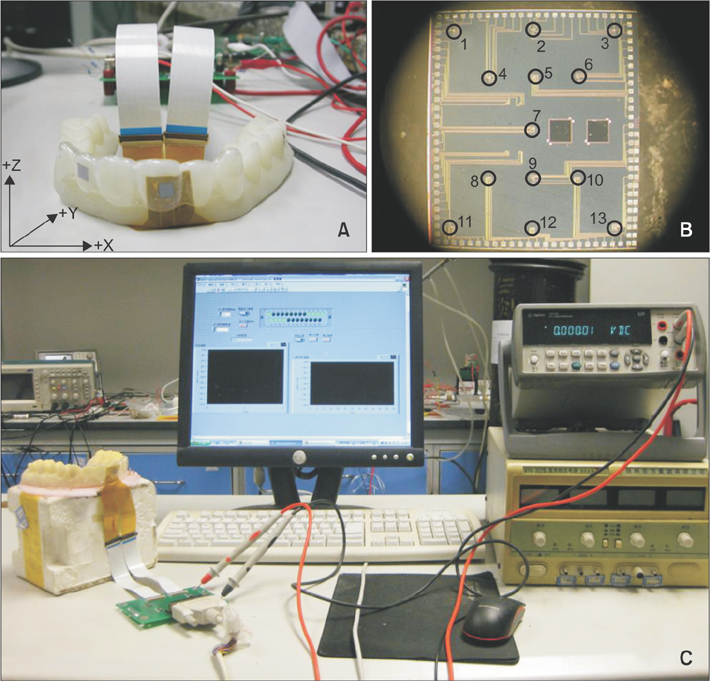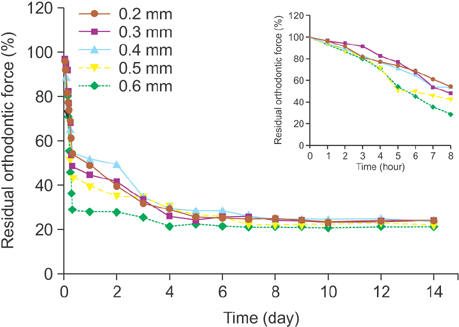Korean J Orthod.
2016 Mar;46(2):65-72. 10.4041/kjod.2016.46.2.65.
Changes in force associated with the amount of aligner activation and lingual bodily movement of the maxillary central incisor
- Affiliations
-
- 1Department of Orthodontics, School of Stomatology, Capital Medical University, Beijing, China. byuxing@263.net
- 2Institute of Microelectronics, Tsinghua University, Beijing, China.
- KMID: 2159353
- DOI: http://doi.org/10.4041/kjod.2016.46.2.65
Abstract
OBJECTIVE
The purposes of this study were to measure the orthodontic forces generated by thermoplastic aligners and investigate the possible influences of different activations for lingual bodily movements on orthodontic forces, and their attenuation.
METHODS
Thermoplastic material of 1.0-mm in thickness was used to manufacture aligners for 0.2, 0.3, 0.4, 0.5, and 0.6 mm activations for lingual bodily movements of the maxillary central incisor. The orthodontic force in the lingual direction delivered by the thermoplastic aligners was measured using a micro-stress sensor system for the invisible orthodontic technique, and was monitored for 2 weeks.
RESULTS
Orthodontic force increased with the amount of activation of the aligner in the initial measurements. The attenuation speed in the 0.6 mm group was faster than that of the other groups (p < 0.05). All aligners demonstrated rapid relaxation in the first 8 hours, which then decreased slowly and plateaued on day 4 or 5.
CONCLUSIONS
The amount of activation had a substantial influence on the orthodontic force imparted by the aligners. The results suggest that the activation of lingual bodily movement of the maxillary central incisor should not exceed 0.5 mm. The initial 4 or 5 days is important with respect to orthodontic treatment incorporating an aligner.
MeSH Terms
Figure
Cited by 1 articles
-
Effects of thermoforming on the physical and mechanical properties of thermoplastic materials for transparent orthodontic aligners
Jeong-Hyun Ryu, Jae-Sung Kwon, Heng Bo Jiang, Jung-Yul Cha, Kwang-Mahn Kim
Korean J Orthod. 2018;48(5):316-325. doi: 10.4041/kjod.2018.48.5.316.
Reference
-
1. Rosvall MD, Fields HW, Ziuchkovski J, Rosenstiel SF, Johnston WM. Attractiveness, acceptability, and value of orthodontic appliances. Am J Orthod Dentofacial Orthop. 2009; 135:276.e1–276.e12.
Article2. Fujiyama K, Honjo T, Suzuki M, Matsuoka S, Deguchi T. Analysis of pain level in cases treated with Invisalign aligner: comparison with fixed edgewise appliance therapy. Prog Orthod. 2014; 15:64.
Article3. Schaefer I, Braumann B. Halitosis, oral health and quality of life during treatment with Invisalign(®) and the effect of a low-dose chlorhexidine solution. J Orofac Orthop. 2010; 71:430–441.
Article4. Harnick DJ. Using clear aligner therapy to correct malocclusion with crowding and an open bite. Gen Dent. 2012; 60:218–223.5. Frongia G, Castroflorio T. Correction of severe tooth rotations using clear aligners: a case report. Aust Orthod J. 2012; 28:245–249.6. Giancotti A, Germano F, Muzzi F, Greco M. A miniscrew-supported intrusion auxiliary for openbite treatment with Invisalign. J Clin Orthod. 2014; 48:348–358.7. Kassas W, Al-Jewair T, Preston CB, Tabbaa S. Assessment of invisalign treatment outcomes using the ABO model grading system. J World Fed Orthod. 2013; 2:e61–e64.
Article8. Casko JS, Vaden JL, Kokich VG, Damone J, James RD, Cangialosi TJ, et al. Objective grading system for dental casts and panoramic radiographs. American Board of Orthodontics. Am J Orthod Dentofacial Orthop. 1998; 114:589–599.9. Rossini G, Parrini S, Castroflorio T, Deregibus A, Debernardi CL. Efficacy of clear aligners in controlling orthodontic tooth movement: a systematic review. Angle Orthod. 2015; 85:881–889.
Article10. Sheridan JJ. The readers' corner. 2. What percentage of your patients are being treated with Invisalign appliances? J Clin Orthod. 2004; 38:544–545.11. Kohda N, Iijima M, Muguruma T, Brantley WA, Ahluwalia KS, Mizoguchi I. Effects of mechanical properties of thermoplastic materials on the initial force of thermoplastic appliances. Angle Orthod. 2013; 83:476–483.
Article12. Fang D, Zhang N, Chen H, Bai Y. Dynamic stress relaxation of orthodontic thermoplastic materials in a simulated oral environment. Dent Mater J. 2013; 32:946–951.
Article13. Rues S, Panchaphongsaphak B, Gieschke P, Paul O, Lapatki BG. An analysis of the measurement principle of smart brackets for 3D force and moment monitoring in orthodontics. J Biomech. 2011; 44:1892–1900.
Article14. Hahn W, Dathe H, Fialka-Fricke J, Fricke-Zech S, Zapf A, Kubein-Meesenburg D, et al. Influence of thermoplastic appliance thickness on the magnitude of force delivered to a maxillary central incisor during tipping. Am J Orthod Dentofacial Orthop. 2009; 136:12.e1–12.e7.
Article15. Hahn W, Engelke B, Jung K, Dathe H, Fialka-Fricke J, Kubein-Meesenburg D, et al. Initial forces and moments delivered by removable thermoplastic appliances during rotation of an upper central incisor. Angle Orthod. 2010; 80:239–246.
Article16. Hahn W, Fialka-Fricke J, Dathe H, Fricke-Zech S, Zapf A, Gruber R, et al. Initial forces generated by three types of thermoplastic appliances on an upper central incisor during tipping. Eur J Orthod. 2009; 31:625–631.
Article17. Ren CC, Bai YX, Wang ZY, Zhang M. [Establishment of the micro-stress sensor measurement system for invisible aligner technique]. Zhonghua Kou Qiang Yi Xue Za Zhi. 2011; 46:600–603. Chinese.18. Tian K, Wang ZY, Zhang M, Liu LT. Design, fabrication, and calibration of a piezoresistive stress sensor on SOI wafers for electronic packaging applications. IEEE Trans Comp Packag Tech. 2009; 32:513–520.
Article19. Shi Y, Ren CC, Hao W, Zhang M, Bai YX, Wang ZY, et al. An ultra-thin piezoresistive stress sensor for measurement of tooth orthodontic force in Invisible aligners. IEEE Sens J. 2012; 12:1090–1097.
Article20. Lapatki BG, Bartholomeyczik J, Ruther P, Jonas IE, Paul O. Smart bracket for multi-dimensional force and moment measurement. J Dent Res. 2007; 86:73–78.
Article21. Lapatki BG, Paul O. Smart brackets for 3D-force-moment measurements in orthodontic research and therapy - developmental status and prospects. J Orofac Orthop. 2007; 68:377–396.
Article22. Boyd RL, Miller RJ, Vlaskalic V. The Invisalign system in adult orthodontics: mild crowding and space closure case. J Clin Orthod. 2000; 34:203–212.23. Sheridan JJ, Ledoux W, McMinn R. Essix appliance: minor tooth movement with divots and windows. J Clin Orthod. 1994; 28:659–663.24. Barbagallo LJ, Shen G, Jones AS, Swain MV, Petocz P, Darendeliler MA. A novel pressure film approach for determining the force imparted by clear removable thermoplastic appliances. Ann Biomed Eng. 2008; 36:335–341.
Article25. Proffit WR, Fields HW. Contemporary orthodontics. 3rd ed. St. Louis: Mosby;2000. p. 341–358.26. Kusy RP. Orthodontic biomaterials: from the past to the present. Angle Orthod. 2002; 72:501–512.27. Eliades T, Bourauel C. Intraoral aging of orthodontic materials: the picture we miss and its clinical relevance. Am J Orthod Dentofacial Orthop. 2005; 127:403–412.
Article28. Ralph WJ. Tensile behaviour of the periodontal ligament. J Periodontal Res. 1982; 17:423–426.
Article
- Full Text Links
- Actions
-
Cited
- CITED
-
- Close
- Share
- Similar articles
-
- A study on the pattern of movement during retraction of maxillary central incisor by finite element method
- Three-dimensional finite element analysis of the bracket positioning plane in lingual orthodontics
- Force Assessment of Thermoformed and Direct-printed Aligners in a Lingual Bodily Movement of a Central Incisor Over Time: A 14-day In Vitro Study
- Effects of clear aligner edentulous space design on distal canine movement: An iterative finite element analysis in cases involving extraction
- Three-dimensional finite element analysis of the phenomenon produced during retraction of four maxillary incisors





